#including the blood pressure monitor
Explore tagged Tumblr posts
Text




season 3 episode 7
#m*a*s*h#mash#maxwell q. klinger#klingerfashionarchive#mashblr#check-up#this outfit looks like something i would have worn in 2008#including the blood pressure monitor#i was 7 years old
14 notes
·
View notes
Text
being diagnosed as diabetic is so annoying my doctors like well that's not great go here and the doctors there are like do you even know if it's type one or type two and I'm like..... no. could be type one could be type two could be a secret third type.... any way. and they're like. well did she at least give you something to manage and track your blood sugars? and I'm like..... no.... should she have? and they're like yeah probably.... any way you should likely eat more and more consistently and I'm like my endocrinologist will heavily disagree with you but okay.
any way my fasting blood sugar was 12.5 this morning.
#i inheritied all my mums shit which included her blood sugar monitor and i got some sample strips from a pharmacy for free bcus im pathetic#and old people feel a need to take care of me that thwy previously have never felt#any way my blood pressure has gone from Very High All The Time to dipping into 'low' territory since starting my migraine preventative which#is good but strange.#any way i dont see my doctor again until like june 15th..... wish me luck
0 notes
Text
This is a RACK focused best practice guide to doing a drowning scene, more specifically a scene where you're repeatedly forcing your victims head under the water. These are my suggestions based on extensive research but they are only theoretical i haven't got to do this to anyone yet. If you have actual experience id love to hear from you please.
Pre-scene setup
Learn CPR. This is the single thing that I'm going to say is mandatory, everything else is just a suggestion this isn't. If worst comes to worst and your victim is drowning you need to be able to save their life.
Learn your victim. How do they react in pain, when they're scared or panicking, where are there mental breaking points. Especially helpful to have done breath play with them before, how long can they hold their breath, how hard will they fight, what are their non verbal cues. Are they the type of person who will push their limits past the danger point, are you comfortable shutting the scene down when they're begging you to continue.
Figure out your nonverbal communication. A safeword is important but not nearly enough for a scene like this. Their head is going to be underwater most if the time and they'll probably be struggling and fighting. What signs can they make to tell you to stop or slow down under these conditions. I would suggest giving them something to hold that can make noise, a squeaky toy or a clicker or something similar, with which to signal you.
During the scene
Use warm water. Cold water adds a whole plethora of new problems significantly increasing the risk. I'm not sure of the exact temperature but I think it should be either room temperature so your victim doesn't feel a temperature difference between the air and the water, or body temperature so the water doesn't change their core temperature. (If you'd like to use cold water or even ice water, if that's part of the appeal, ill happily figure out the additional risks in exchange for a video of you drowning your victim ^.^)
Watch their face. Like any other form of breath play hypoxia is a major risk. This post isn't about breath play, I'm assuming you know all those risks and how to manage them before you do something like this.
Start slow. Put your hand on their head but let them submerge themselves and then come back up when they're ready. This will get them used to the sensation and you used to the rhythm. Slowly increase pressure and intensity until you're forcing their head under and pulling it up against their will.
Have the person fill their lungs to capacity before submerging them. The reason being they will have to breath out before they breath water back in so as soon as you see the first sign of bubbles you can pull them out.
After care
This scene will be intense so the aftercare needs to be too. Again this post isn't about proper aftercare I'm assuming you know how to do that if you're doing something like this. But in addition to the usual.
Have a plan for monitoring your victim for the next 72 hours. There are two major complications that can occur after a drowning incident and both can take days to present themselves. The first is when a persons throat spasms and closes, this is supposed to happen when they initially inhale water but can happen much later. The signs to look out for include persistent coughing, irregular breathing, dizziness, confusion, and foam around the mouth and nose. The second is when water gets deep into the lunges it can cause fluid to build up which inhibits gas exchange causing the person to slowly suffocate. The signs to look out for can include coughing up blood, excessive sweating, anxiety, pale skin, and a crackling sound when breathing deeply. If your victim shows any of these signs get them to a medical professional asap, don't risk it these will both cause very painful death.
Enjoy ^.^
468 notes
·
View notes
Text
Round 1 - Phylum Arthropoda



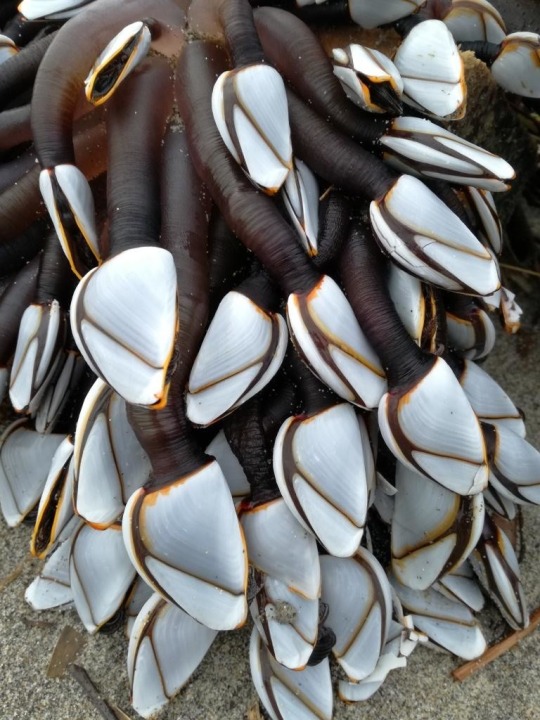
(Sources - 1, 2, 3, 4)
Arthropoda is a phylum of animals that have segmented bodies, possess a chitin exoskeleton, and have paired segmented appendages. They are colloquially called “bugs” though this is often only used for terrestrial arthropods, and sometimes only used for insects specifically.
After Nematoda, this is the most successful phylum, and it is far more diverse, with up to 10 million species! Arthropods account for 80% of all known living animal species. The three major subphyla include the Chelicerates (sea spiders, horseshoe crabs, arachnids, and the extinct eurypterids and chasmataspidids), the Myriapods (centipedes and millipedes), and the Crustaceans (shrimps, prawns, crabs, lobsters, crayfish, seed shrimp, branchiopods, fish lice, krill, remipedes, isopods, barnacles, copepods, opossum shrimps, amphipods, mantis shrimp, entognaths, and insects).
Arthropods are so diverse in fact that it is next to impossible for me to describe a model arthropod. They are important members of marine, freshwater, land, and air ecosystems and are one of only two major animal groups that have adapted to life in dry environments, the others being chordates. All arthropods have an exoskeleton and must molt as they grow, replacing their exoskeleton. Some arthropods go through a metamorphosis in this process. They have brains, a heart, and blood (called hemolymph, though some crustaceans and insects also use hemoglobin). They sense the world through small hairs called setae which are sensitive to vibration, air currents, and even chemicles in the air or water. Pressure sensors function similarly to eardrums. Antennae monitor humidity, moisture, temperature, sound, smell, and/or taste, depending on species. Most arthropods have sophisticated visual systems ranging from simple eyes (ocelli) which orient towards light, to compound eyes consisting of fifteen to several thousand independent ommatidia capable of forming images, detecting fast movement, or even seeing polarized or ultra-violet light. Some arthropods are hermaphroditic, some have more than two sexes, some reproduce by parthenogenesis, some by internal fertilization, some by external, some have complex courtship rituals, some lay eggs, some give live birth, some have prolonged maternal care. The first arthropods are known from the Ediacaran, before the Cambrian era.

Propaganda below the cut:
Insects are the first animals to have achieved flight
The smallest arthropods are the parasitic crustaceans of the class Tantulocarida, some of which are less than 100 micrometres long. The largest arthropod is the Japanese Spider Crab (Macrocheira kaempferi) with a legspan of up to 4 metres (13 ft) long. The heaviest is the American Lobster (Homarus americanus), which can get up to 20 kilograms (44 lb).
Many arthropods are popular pets, including various species of crab, shrimp, isopod, crayfish, mantis shrimp, millipede, centipede, tarantula, true spider, scorpion, amblypygid, vinegaroon, mantis, cockroach, beetle, moth, and ant! Some are even domesticated, including silk moths and honeybees.
Many arthropods are eaten by humans as a delicacy, and farming insects for food is considered more sustainable than farming large chordates. These farmed arthropods are referred to as “minilivestock.”
Arthropods feature in a variety of ways in biomimicry: humans imitating elements of nature. For example, the cooling system of termite mounds has been imitated in architecture, and the internal structure of the dactyl clubs of mantis shrimp have been imitated to create more damage tolerant materials.
Spider venoms are being studied as a less harmful alternative to chemical pesticides, as they are deadly to insects but the great majority are harmless to vertebrates. They have also been studied and could have uses in treating cardiac arrhythmia, muscular dystrophy, glioma, Alzheimer's disease, strokes, and erectile dysfunction.
Shellac is a resin secreted by the female Lac Bug (Kerria lacca) on trees in the forests of India and Thailand. It is used as a brush-on colorant, food glaze, natural primer, sanding sealant, tannin-blocker, odour-blocker, stain, and high-gloss varnish. It was once used in electrical applications as an insulator, and was used to make phonograph and gramophone records until it was replaced by vinyl.
One of the biggest ecosystem services arthropods provide for humans is pollination. Crops where pollinator insects are essential include brazil nuts, cocoa beans, and fruits including kiwi, melons, and pumpkins. Crops where pollinator insects provide 40-90% of pollination include avocados, nuts like cashews and almonds, and fruits like apples, apricots, blueberries, cherries, mangoes, peaches, plums, pears, and raspberries. In crops where pollinators are not essential they still increase production and yield. Important pollinators include bees, flies, wasps, butterflies, and moths.
Many arthropods are sacred to humans. In Ancient Egypt, scarab beetles were used in art, religious ceremonies, and funerary practices, and were represented by the god Khepri. Bees supposedly grew from the tears of the sun god Ra, spilled across the desert sand. The goddess of healing venomous bites and stings, Serket, was depicted as a scorpion. Kalahari Desert's San People tell of a legendary hero, Mantis, who asked a bee to guide him to find the purpose of life. When the bee became weary from their search, he left the mantis on a floating flower, and planted a seed within him before passing from his exhaustion. The first human was born from this seed. In Akan folklore, the cunning trickster figure Anansi/Ananse is depicted as a spider. Western astrology uses the crab constellation, called Cancer, and the scorpion constellation, called Scorpio. Dragonflies symbolize pure water in Navajo tradition. In Anishinaabe culture, dreamcatchers are meant to represent spiderwebs and are used as a protective charm for infants. They originate from the Spider Grandmother, who takes care of the children and the people of the land in many Native American cultures. The Moche people of ancient Peru often depicted spiders and crabs in their art. In an Ancient Greek hymn, Eos, the goddess of the dawn, requests of Zeus to let her lover Tithonus live forever as an immortal. Tithonus became immortal, but not ageless, and eventually became so small, old, and shriveled that he turned into the first cicada. Another hymn sings of the Thriae, a trinity of Aegean bee nymphs. Native Athenians wore golden grasshopper brooches to symbolize that they were of pure, Athenian lineage. In an Ancient Sumerian poem, a fly helps the goddess Inanna when her husband Dumuzid is being chased by galla demons. In Japanese culture, butterflies carry many meanings, from being the souls of humans to symbols of youth to guides into the afterlife. Ancient Romans also believed that butterflies were the souls of the dead. Some of the Nagas of Manipur claim ancestry from a butterfly. Many cultures use the butterfly as a symbol of rebirth. And the list goes on…
cute crab eat a strawbebby:
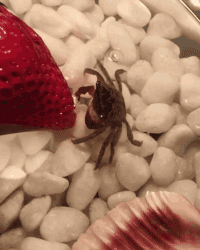
#round 1#animal polls#listen narrowing it down to just 4 images almost killed me#if arthropods don’t move on to round 2 I will have to take like an extra week off to mourn that I can’t show you all the cool bugs#there’s so many cool bugs guys#i chose the orchid mantis over a trilobite beetle and a poofy little bee fly cause I figured it had broader appeal#and used a horseshoe crab instead of a spider cause people are so Weird about spiders I worried it would impact the numbers#sigh#anyway I’m really hoping for Chordata Arthropoda Mollusca as top three#other phyla are all great but these three would make for the most interesting Round 2 imo
238 notes
·
View notes
Text

new set of pics on OnlyFans! Where are all the intubation lovers? Including some spicy ones without the jock by popular request :p
Nathan is in ICU, the machine does the breathing for him, he's too weak to breathe on his own. Hooked to an ECG monitor and an automated blood pressure cuff.
OnlyFans.com/nathansheartbeat
120 notes
·
View notes
Text
Kavitha Surana at ProPublica:
In her final hours, Amber Nicole Thurman suffered from a grave infection that her suburban Atlanta hospital was well-equipped to treat. She’d taken abortion pills and encountered a rare complication; she had not expelled all of the fetal tissue from her body. She showed up at Piedmont Henry Hospital in need of a routine procedure to clear it from her uterus, called a dilation and curettage, or D&C. But just that summer, her state had made performing the procedure a felony, with few exceptions. Any doctor who violated the new Georgia law could be prosecuted and face up to a decade in prison. Thurman waited in pain in a hospital bed, worried about what would happen to her 6-year-old son, as doctors monitored her infection spreading, her blood pressure sinking and her organs beginning to fail. It took 20 hours for doctors to finally operate. By then, it was too late.
The otherwise healthy 28-year-old medical assistant, who had her sights set on nursing school, should not have died, an official state committee recently concluded.
Tasked with examining pregnancy-related deaths to improve maternal health, the experts, including 10 doctors, deemed hers “preventable” and said the hospital’s delay in performing the critical procedure had a “large” impact on her fatal outcome. Their reviews of individual patient cases are not made public. But ProPublica obtained reports that confirm that at least two women have already died after they couldn’t access legal abortions and timely medical care in their state. There are almost certainly others. Committees like the one in Georgia, set up in each state, often operate with a two-year lag behind the cases they examine, meaning that experts are only now beginning to delve into deaths that took place after the Supreme Court overturned the federal right to abortion.
Thurman’s case marks the first time an abortion-related death, officially deemed “preventable,” is coming to public light. ProPublica will share the story of the second in the coming days. We are also exploring other deaths that have not yet been reviewed but appear to be connected to abortion bans. Doctors warned state legislators women would die if medical procedures sometimes needed to save lives became illegal. Though Republican lawmakers who voted for state bans on abortion say the laws have exceptions to protect the “life of the mother,” medical experts cautioned that the language is not rooted in science and ignores the fast-moving realities of medicine.
The most restrictive state laws, experts predicted, would pit doctors’ fears of prosecution against their patients’ health needs, requiring providers to make sure their patient was inarguably on the brink of death or facing “irreversible” harm when they intervened with procedures like a D&C. “They would feel the need to wait for a higher blood pressure, wait for a higher fever — really got to justify this one — bleed a little bit more,” Dr. Melissa Kottke, an OB-GYN at Emory, warned lawmakers in 2019 during one of the hearings over Georgia’s ban. Doctors and a nurse involved in Thurman’s care declined to explain their thinking and did not respond to questions from ProPublica. Communications staff from the hospital did not respond to multiple requests for comment. Georgia’s Department of Public Health, which oversees the state maternal mortality review committee, said it cannot comment on ProPublica’s reporting because the committee’s cases are confidential and protected by federal law.
The availability of D&Cs for both abortions and routine miscarriage care helped save lives after the 1973 Supreme Court ruling in Roe v. Wade, studies show, reducing the rate of maternal deaths for women of color by up to 40% the first year after abortion became legal. But since abortion was banned or restricted in 22 states over the past two years, women in serious danger have been turned away from emergency rooms and told that they needed to be in more peril before doctors could help. Some have been forced to continue high-risk pregnancies that threatened their lives. Those whose pregnancies weren’t even viable have been told they could return when they were “crashing.” Such stories have been at the center of the upcoming presidential election, during which the right to abortion is on the ballot in 10 states.
Thurman, who carried the full load of a single parent, loved being a mother. Every chance she got, she took her son to petting zoos, to pop-up museums and on planned trips, like one to a Florida beach. “The talks I have with my son are everything,” she posted on social media.
But when she learned she was pregnant with twins in the summer of 2022, she quickly decided she needed to preserve her newfound stability, her best friend, Ricaria Baker, told ProPublica. Thurman and her son had recently moved out of her family’s home and into a gated apartment complex with a pool, and she was planning to enroll in nursing school. The timing could not have been worse. On July 20, the day Georgia’s law banning abortion at six weeks went into effect, her pregnancy had just passed that mark, according to records her family shared with ProPublica. Thurman wanted a surgical abortion close to home and held out hope as advocates tried to get the ban paused in court, Baker said. But as her pregnancy progressed to its ninth week, she couldn’t wait any longer. She scheduled a D&C in North Carolina, where abortion at that stage was still legal, and on Aug. 13 woke up at 4 a.m. to make the journey with her best friend.
On their drive, they hit standstill traffic, Baker said. The clinic couldn’t hold Thurman’s spot longer than 15 minutes — it was inundated with women from other states where bans had taken effect. Instead, a clinic employee offered Thurman a two-pill abortion regimen approved by the U.S. Food and Drug Administration, mifepristone and misoprostol. Her pregnancy was well within the standard of care for that treatment. Getting to the clinic had required scheduling a day off from work, finding a babysitter, making up an excuse to borrow a relative’s car and walking through a crowd of anti-abortion protesters. Thurman didn’t want to reschedule, Baker said. At the clinic, Thurman sat through a counseling session in which she was told how to safely take the pills and instructed to go to the emergency room if complications developed. She signed a release saying she understood. She took the first pill there and insisted on driving home before any symptoms started, Baker said. She took the second pill the next day, as directed.
Deaths due to complications from abortion pills are extremely rare. Out of nearly 6 million women who’ve taken mifepristone in the U.S. since 2000, 32 deaths were reported to the FDA through 2022, regardless of whether the drug played a role. Of those, 11 patients developed sepsis. Most of the remaining cases involved intentional and accidental drug overdoses, suicide, homicide and ruptured ectopic pregnancies. Baker and Thurman spoke every day that week. At first, there was only cramping, which Thurman expected. But days after she took the second pill, the pain increased and blood was soaking through more than one pad per hour. If she had lived nearby, the clinic in North Carolina would have performed a D&C for free as soon as she followed up, the executive director told ProPublica. But Thurman was four hours away.
The consequences of draconian abortion bans are being felt, as at least two women in Georgia died over being denied emergency medical care.
#Abortion Bans#Georgia#Abortion#Dobbs v. Jackson Women's Health Organization#Dilation and Curettage#Amber Nicole Thurman#Abortion Medication#Georgia HB481
125 notes
·
View notes
Note
Could you do Platonic Yanderes Endeavor (reformed), Aizawa, Izuku, Mirio, and Bakugou with a daughter/ sister reader meeting up with the reader, and see her in this skimpy outfit being hit on by a bunch of guys. But the thing is she is totally into it and flirting with them too.

Clubbing Culture Sibling Reader | Yandere Boku No Hero Academia
The flirty and sex-filled nature of clubbing isn’t for everyone. Especially not heroes who have everything to lose should they get out of hand. But when their dearest younger sibling decides to pursue a life such as this they can’t leave them to their own devices. Especially since you seem so willing to taint your perfection:
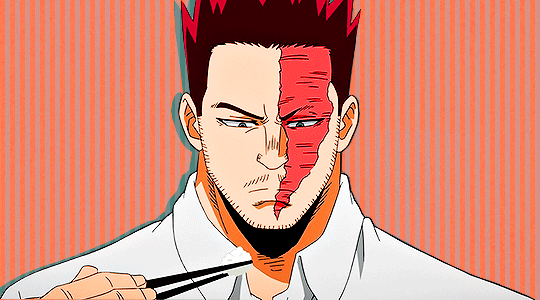
Endeavor (Reformed)
Family is important…especially now that he’s trying to fix his
If you were his child you wouldn’t so much as leave the house without wearing a full-on hazmat suit
But you're not, you’re his younger sibling
Legally old enough to do as you, please
Without your brother playing his ‘guardian’ card
But that doesn’t stop him from heavily urging pleading+ to be invited to your outing
And just like you thought…it was a terrible idea
He doesn’t need to burn anyone he can’t anyways too many eyes
His glare alone sends those interested in you packing
He can’t stop you from wearing what you do or flirting with who you like
but the latest victims will wish you hadn’t
“I wish you weren’t so….you. Especially with those who don’t deserve you.”

Aizawa Shota
Naturally, as your older brother, he makes a point to monitor you
That includes your typical behavior
He doesn’t have to like it, he knows it's just how you are
No the problem he has is the absolute scum that are just too forward
As per usual he’ll cull them mercilessly
While burying the remains he’ll realize how ironic it is that those who successfully earn your attention end up earning an unmarked grave
“This is just the way things go. If my baby sibling was a bit less…friendly I wouldn’t be so adamant about ending you like this. But it's just the way things go.”

Togata Mirio
Your glorious big bro always smiling and cheering you on
There are very few people who can look past that and see the murderous intent he has
Something that comes up pretty much whenever he’s reminded of your attitude about this sort of thing
It bothers him deeply and genuinely raises his blood pressure that you even entertain this
And when you turn to him with that cute tilt of your head as you ask him what’s wrong
He’ll smile and lie because he’s such a good brother
But eventually, he’ll get it together
And as your beloved big brother, he’ll be ‘revoking’ your party privileges
“Sorry sorry (Y/n)! You know big brother’s just looking out for you, so trust me on this okay?”

Midoriya Izuku
He’s always been proud of your confidence
And when you were little he was proud of how you easily valued your ‘no-no squares’
But now you're grown and you don’t abide by those rules at all
It bothers him
And he’s willing to reason with you…for a little while
But after you brush off his warnings and outright justify your behavior he decides he’s done
Done with your autonomy in general
In his mind, if you can’t handle being responsible about who you pursue, you’re not fit to enjoy clubbing or partying or flirting at all
And he decides this by trapping you
But don’t worry he knows his baby sibling is all grown up now so he’ll have another method for keeping you in place
Like becoming the insistent stalker that’s making you too paranoid to leave the house
Or the one making sure you need to be inside to receive the package that has to be signed by you
“I told you I didn’t like it. You didn’t listen, now look at what you’ve done.”

Bakugo Katsuki
Is he not above just scooping you up and taking you home
The second you so much as smile at someone he’s decided he’s disgusted enough to send you home and brutalize them later
He will in fact lecture you every time about etiquette and the extras you have to ignore
Yes, if he’s overseas expect a costly call for his 3-hour rant
If you still don’t tone it back, to his liking, or not at all he’s not above putting you in an uncomfortable or dangerous corner
Maybe letting the villain he’s chasing believe they disappeared into the club’s crowd
Letting the villain shoot their shot
Only to interrupt and immediately take you, hostage
Surely you’ll see his side then
“Well isn’t that funny? I was freaking right!”
#yandere enji todoroki#yandere enji x reader#yandere enji#yandere x reader#yandere x you#lovelyyandereaddictionpoint#yanderexrea#yandere#yanderes#yandere endeavor#yandere bakugo katsuki#yandere izuku midoriya#yandere izuku x reader#yandere izuku#yandere bakugou#yandere bakugo x reader#yandere togata mirio#yandere mirio togata x reader#yandere mirio togata#yandere mirio x reader#yandere mirio#yandere aizawa x reader#yandere aizawa#yandere eraserhead#yandere my hero academia#yandere boku no hero academia#yandere mha x reader#yandere mha#yandere bnha#yandere heroes
597 notes
·
View notes
Note
i couldn’t exactly find out if your requests were open or not, so feel free to ignore this if they are but can you do a platonic yandere heavy or medic x reader ?
TF2 platonic yandere mercs hcs
gn reader | thanks for the ask anon!
tw: yandere behaviours includes: heavy, medic
drabbles under the cut :P
Heavy: - Heavy’s love for you comes in the form of an overwhelming need to protect you at all costs - no one is allowed near you unless they pass his strict approval - Even if you don’t see him, Heavy always knows where you are and what you’re doing - He's is always close, and his imposing size makes it impossible to escape his presence - He’s convinced that only he can keep you safe from the dangers of the world, including his own teammates - While Heavy doesn’t resort to violence with you, he isn’t above using his presence and tone to scare anyone he perceives as a threat to your safety or well-being - He believes it’s his duty to take care of all your needs, from food to shelter, ensuring you never have to rely on anyone but him - He won’t outright forbid you from doing things, but he’ll make you feel like you should always stay close to him - “You are safest with Heavy,” he’ll say in that deep, soothing voice, slowly making you doubt your own independence
Medic: - Medic views you as his most prized subject, and that curiosity bleeds into every interaction - he constantly monitors your health, both mentally and physically, often conducting “checkups” on you without asking - You’ll find yourself waking up to him taking your blood pressure or measuring your heart rate, always under the guise of caring for you - Medic wants to know everything about you - your habits, thoughts, and feelings - If he feels someone is negatively influencing you, Medic won’t hesitate to interfere, he'll secretly administer a sedative or concoct a reason to separate you from them - always believing it’s for your own good - He’ll often pull you aside to help with his experiments or keep you occupied under the pretense that he needs your assistance (in reality he just doesn't want you spending time with anyone else) - If you ever express discomfort or try to distance yourself, Medic will make you feel like you’re being ungrateful for his “care” - he’ll remind you how much he’s done for you and how lost you’d be without his medical expertise - He might become desperate, reassuring you with unsettling intensity, “No one cares for you like I do.”
#ask#tf2#team fortress 2#tf2 fanfiction#tf2 imagines#tf2 x reader#tf2 x you#jermer10#tf2 heavy#tf2 heavy x reader#tf2 medic#tf2 medic x reader#yandere
81 notes
·
View notes
Text
It's been a while so I thought I'd share some Private Clinic wip updates with y'all.
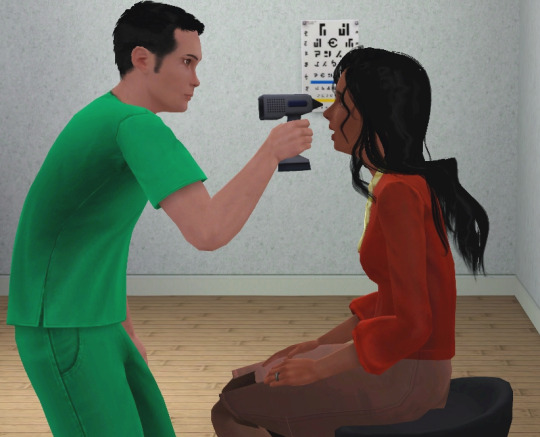
I'm pretty much finished with the Optometry module. With it, certain Sims will get an astigmatism and will need prescription glasses. Sims will need to get regular check ups to avoid worsening their astigmatism. There are also other issues Sims can get, particularly kids and elders that optometrists can treat. It's the smallest of the 5 medical modules I've planned so that's about the extent of it but as someone who's been wearing glasses since I was 10. It makes me happy to curse my Sims with an astigmatism too.
Also added some new features to the Clinic Controller to make it easier to run a clinic, including the ability to schedule appointments, either for yourself or for a family member (even babies and toddlers), which you can do in person or online.
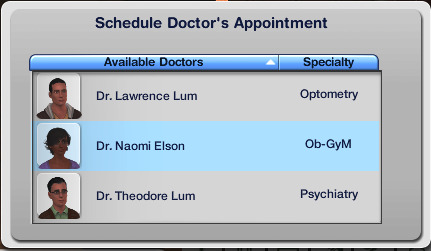


I've started on the ObGyM stuff now for females/pregnant Sims though it's really more just obstetrics. Here's my Obgym giving an ultrasound to a patient (and probably prescribing she get a new husband 😅).
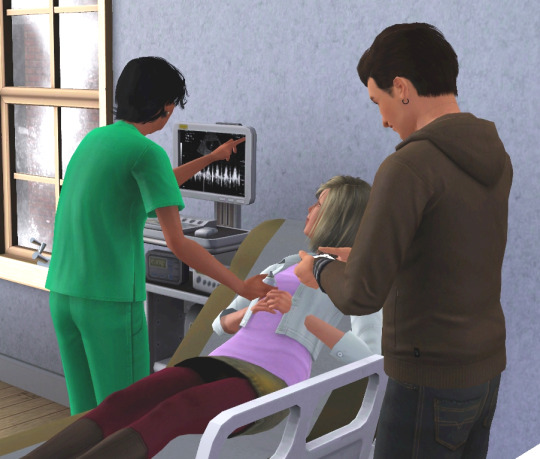
Pregnant Sims can get ultrasounds, blood tests and examinations to make sure the pregnancy is on track. Having daily check ups will improve the pregnancy and ensure a healthy baby or avoid any issues. You'll also get a sonogram from the ultrasound to show to other Sims to announce your pregnancy.

Thanks so much to everyone that replied to my request for pregnancy ideas, some of which I've incorporated. The module makes pregnancies less predictable and a bit more challenging. Being pregnant drains hunger, bladder and energy, gives variable due dates and weight gain, and monitors blood pressure, blood sugar and iron levels which are affected by diet and can bring on health complications if too high or low. Sims also get more nausea, heartburn, gas (fun!). I'm also thinking of making the pregnancy books more useful by including information about how the custom pregnancy state by reading them.

I love the original NonaMena breastfeeding mod but have always wanted something that has more impact for both nursing parents and babies so it makes sense to incorporate it into the obgym module where nursing has health benefits for the baby. Also the state/health of the mother affects how effective nursing is and how it impacts the baby. Stressed moms may have trouble producing milk.

Finally, I have decided to do live hospital births so OBs can deliver babies in the clinic. I'll share more details on that at a later date but I'm excited to put some interesting gameplay aspects in it.
307 notes
·
View notes
Text
A Writer's Blueprint for Realistic Drowning Scenes

This guide is designed to help writers depict drowning scenes with authenticity and detail. I’ll walk you through the step-by-step process of drowning, the physical signs to look for and clear up some common misconceptions. With this information, you’ll have the tools to craft vivid, compelling, and believable drowning scenarios that will captivate your readers and add depth to your narrative.
Fair warning; this is a comprehensive and pretty explicit guide, so if you're uncomfortable with those topics, please just scroll away.
The Stages of Drowning
1. Initial Entry
When a person first enters the water, especially unexpectedly, their initial reaction is often one of shock and panic. The sudden change in environment, temperature, and the feeling of being submerged triggers an immediate response from the body.
Shock Response
Cold Water Immersion: Sudden immersion in cold water can cause a cold shock response, which includes involuntary gasping, hyperventilation, and a rapid increase in heart rate and blood pressure.
Panic and Disorientation: The person may become disoriented and panic, struggling to stay afloat and breathe normally.
2. Involuntary Breath-Holding
As the person struggles to keep their head above water, they instinctively hold their breath to prevent water from entering their lungs.
Burning Sensation in Lungs
The buildup of carbon dioxide in the blood creates a burning sensation in the lungs, which intensifies the feeling of panic.
Increased Heart Rate and Blood Pressure
The body's stress response causes an increase in heart rate and blood pressure, further depleting oxygen reserves.
3. Uncontrolled Breathing
When the person can no longer hold their breath, the body's reflexes take over, leading to involuntary attempts to breathe.
Aspiration of Water
Water enters the mouth and is aspirated into the lungs, causing coughing, choking, and a strong gag reflex.
Coughing and Choking
The person may cough and choke as water enters the respiratory tract, leading to more panic and struggle.
Gasping for Air
The body's desperate attempt to get oxygen leads to gasping, but often results in inhaling more water.
4. Laryngospasm
The body's protective reflex to prevent water from entering the lungs can cause the vocal cords to spasm, temporarily sealing the airway.
Temporary Airway Closure
The laryngospasm closes the airway, preventing both water and air from entering the lungs.
Increased CO2 and Decreased O2
As carbon dioxide levels rise and oxygen levels fall, the person becomes increasingly hypoxic.
5. Loss of Consciousness
Due to the lack of oxygen, the person loses consciousness.
Hypoxia and Hypercapnia
Hypoxia (lack of oxygen) and hypercapnia (excess carbon dioxide) cause confusion, dizziness, and loss of motor control.
Fading Senses
Vision blurs, hearing diminishes, and the sense of touch becomes numb.
Blackout
The brain, deprived of oxygen, shuts down, leading to unconsciousness.
6. Cardiac Arrest
Prolonged oxygen deprivation leads to cardiac arrest, where the heart stops beating.
Cessation of Breathing
Respiratory effort ceases as the brain's control over breathing is lost.
Heart Stops Beating
The heart, deprived of oxygen, stops beating, leading to complete circulatory failure.
Brain Damage and Death
Without intervention, brain cells die from lack of oxygen, leading to permanent brain damage and eventually death.
7. Aftermath (if Rescued)
If the person is rescued and resuscitated, there are immediate and long-term consequences to consider.
Immediate Aftermath
CPR and First Aid: Immediate resuscitation efforts, including CPR and the use of a defibrillator if necessary.
Hospitalization: The person will likely need to be hospitalized for further treatment and monitoring.
Long-Term Effects
Lung Damage: Inhalation of water can cause damage to the lung tissues, leading to conditions like pneumonia or acute respiratory distress syndrome (ARDS).
Neurological Damage: Prolonged lack of oxygen can result in brain damage, affecting cognitive and motor functions.
Psychological Impact: Survivors may experience PTSD, anxiety, and a lasting fear of water.
Physical Appearance During Drowning
1. Initial Entry
Shock Response
Wide Eyes and Gasping Mouth: Eyes are wide open, and the mouth is often open in a gasp or scream.
Flailing Limbs: Arms and legs are moving rapidly in an attempt to regain balance and stay afloat.
2. Involuntary Breath-Holding
Tensed Muscles
Rigid Body: Muscles are tensed, and the body may appear stiff as the person tries to maintain control.
Strained Facial Expression: The face may show strain, with furrowed brows and tightly closed eyes.
3. Uncontrolled Breathing
Coughing and Choking
Reddened Face and Eyes: The face may turn red from the effort of coughing and choking.
Foaming at the Mouth: A frothy mixture of saliva and water may be visible around the mouth.
Gasping for Air
Open Mouth and Wide Eyes: The mouth is open wide in an attempt to gasp for air, and the eyes may be bulging with fear.
Erratic Movements: The person’s movements become more erratic and uncoordinated as they struggle to breathe.
4. Laryngospasm
Silent Struggle
Mouth Opening and Closing: The person may appear to be gasping silently as the airway is temporarily sealed.
Clenching Throat: Hands may instinctively clutch at the throat in a futile attempt to open the airway.
5. Loss of Consciousness
Limp Body
Floating Limply: The body becomes limp and may float face down or sink slightly below the surface.
Pale or Blue Skin: Skin may turn pale or blue (cyanosis) due to lack of oxygen.
Relaxed Facial Features
Closed Eyes: Eyes close as the person loses consciousness.
Slack Jaw: The jaw may go slack, and the mouth could be partially open.
6. Cardiac Arrest
Unconsciousness
Still Body: The body is completely still, with no voluntary movements.
Gray or Blue Skin: Skin color becomes ashen, gray, or blue, particularly around the lips and extremities.
7. After Drowning (Post-Rescue Appearance)
If the person is rescued, their appearance post-drowning can indicate the extent of their ordeal and the immediate aftermath.
Immediate Aftermath
Waterlogged Clothing: Clothes may be heavy and waterlogged, clinging to the body.
Coughing and Vomiting: The person may cough up water or vomit as they are resuscitated.
Shivering: If the water was cold, the person might be shivering uncontrollably due to hypothermia.
Long-Term Appearance
Bruising and Cuts: There may be bruises or cuts from the struggle in the water or the rescue process.
Pale or Blue Skin: Skin color might still show signs of cyanosis if oxygen levels are low.
Labored Breathing: Breathing may remain labored and shallow as the lungs recover.
Ways to Drown
Being Tied Down with a Stone
An ancient method where a person is weighted down with a heavy object, preventing them from surfacing.
Pulled Under by a Strong Current
Strong currents or rip tides can overpower a swimmer, pulling them away from safety and making it difficult to stay afloat.
Trapped Under a Capsized Boat
In the event of a boat capsizing, a person can become trapped underneath, unable to reach the surface for air.
Caught in Underwater Vegetation
Dense underwater plants can entangle a swimmer, restricting their movements and preventing them from surfacing.
Unable to Swim in Deep Water
Lack of swimming skills or fatigue in deep water can lead to drowning if the person cannot keep themselves afloat.
Falling Through Ice
Falling through thin ice can trap a person in freezing water, with the ice making it difficult to find an exit.
Getting Caught in a Riptide
A riptide can drag a swimmer out to sea, making it hard to swim back to shore due to the strong current.
Swimming Exhaustion
Overexertion while swimming can lead to exhaustion, making it impossible to continue treading water or swimming to safety.
Diving Accident
A diving mishap, such as hitting one’s head or getting disoriented underwater, can result in drowning.
Shipwreck
In a shipwreck scenario, a person may be stranded in open water, facing potential drowning due to exhaustion, exposure, or lack of flotation devices.
Common Misconceptions About Drowning
1. Drowning is Always Loud and Dramatic
Many people believe that drowning involves a lot of splashing, shouting, and waving for help. In reality, drowning is often a silent and quick event.
Instinctive Drowning Response: When a person is drowning, their body prioritizes breathing over waving or shouting. The struggle to get air means they can’t call for help.
Quiet Struggle: Drowning individuals might be bobbing up and down, with their mouths at water level, making little noise as they gasp for air.
2. People Always Recognize Drowning
It's a common belief that drowning is easily recognizable. However, many drownings go unnoticed until it’s too late.
Subtle Signs: Drowning can look like someone treading water or trying to swim. Signs can be subtle, such as bobbing up and down, head tilted back with mouth open, or eyes glassy and empty.
Misinterpreted Behaviors: Bystanders might mistake a drowning person for someone playing or simply floating.
3. Only Weak Swimmers Drown
Many assume that only those who can’t swim well are at risk of drowning, but even strong swimmers can drown under certain conditions.
Fatigue and Cramps: Strong swimmers can become exhausted, suffer from cramps, or panic, leading to drowning.
Environmental Factors: Strong currents, cold water, and underwater hazards can overwhelm even the best swimmers.
4. Drowning Happens Immediately
There’s a misconception that drowning happens instantly. While it can be quick, it often takes a few minutes for a person to drown.
Struggling Phase: The initial struggle can last for 20-60 seconds, during which the person is trying to stay afloat and breathe.
Silent Submersion: After this, they may silently submerge, often unnoticed.
5. Drowning Only Happens in Deep Water
Many people think that drowning only occurs in deep water. However, shallow water can be just as dangerous.
Shallow Water Drowning: Drowning can occur in as little as a few inches of water, especially with young children or if someone is unconscious.
Bathtubs and Pools: Many drownings occur in bathtubs, kiddie pools, or even buckets.
6. Life Jackets Are Only Needed on Boats
It's commonly believed that life jackets are only necessary when boating, but they are crucial in many other water-related activities.
Swimming and Water Sports: Life jackets provide essential buoyancy and can save lives in swimming pools, lakes, rivers, and during water sports.
Unexpected Situations: Wearing a life jacket can prevent drowning in unexpected situations, like sudden falls into water.
7. People Float After Drowning
A prevalent myth is that drowning victims float on the surface after they die, but this is not always the case.
Initial Sinking: Initially, a drowned body may sink due to the density of the tissues and lack of air in the lungs.
Later Floating: Bodies often float later due to gas buildup from decomposition, but this can take days.
8. Drowning Victims Always Look Distressed
People often think that drowning victims will look distressed or visibly in danger, but many can appear calm and quiet.
Passive Drowning: Drowning individuals may appear to be calmly treading water or just floating.
Lack of Visible Struggle: There may be no visible struggle, making it hard to identify the danger.
9. CPR is Ineffective After Drowning
Some believe that once a person has drowned, CPR cannot help. However, immediate CPR can be life-saving.
Restarting Breathing: CPR can help restart the victim’s breathing and circulation, buying crucial time until emergency services arrive.
Rescue Breathing: Effective rescue breathing can oxygenate the lungs and increase the chances of revival.
Resources
Books
"The Science of Drowning" by Sports Aid Intl
“It offers a significant departure from how drowning is traditionally treated by combining discussions about medical, prevention, and intervention issues.”
Link
"The Perfect Storm: A True Story of Men Against the Sea" by Sebastian Junger
A gripping account of the 1991 storm that hit the North Atlantic and the fishermen caught in its deadly grip, providing insights into the perilous nature of the sea and drowning.
Link
Articles
"Drowning vs Aquatic Distress" by Crunderwood
An article detailing the science of drowning + some interesting points.
Link to article
"Drowning Victim" by SLRG
How to identify a drowning person besides the typical flailing.
Link to article
"Drowning Treatment" by WebMD
Guidelines and tips for healing/treating a drowning person.
Link to article
Websites
American Red Cross: Water Safety Tips
Provides extensive information on water safety, drowning prevention, and emergency response.
Link to website
National Drowning Prevention Alliance
A dedicated organization focused on preventing drowning through education, research, and advocacy.
Link to website
Centers for Disease Control and Prevention (CDC): Drowning Prevention
Offers statistics, prevention strategies, and safety tips to reduce the risk of drowning.
Link to website
Looking For More Writing Tips And Tricks?
Are you an author looking for writing tips and tricks to better your manuscript? Or do you want to learn about how to get a literary agent, get published and properly market your book? Consider checking out the rest of Quillology with Haya Sameer; a blog dedicated to writing and publishing tips for authors! While you’re at it, don’t forget to head over to my TikTok and Instagram profiles @hayatheauthor to learn more about my WIP and writing journey!
#hayatheauthor#haya's book blog#haya blogs#blog masterlist#writing community#writing tools#writer things#writing advice#writer community#writing techniques#writing prompt#writing stuff#creative writing#ya writing advice#writing tips and tricks#writer tools#writers of tumblr#writer blog#writers block#writers on tumblr#writerscommunity#writer stuff#author help#author advice#writing emotions#how to write emotions#emotional writing#writing#author
90 notes
·
View notes
Text

The Racing Heart Part 1
Doctor Barnes has a new patient in the waiting room having anxiety issues. She greets her and chats a bit about what is going on in her daily life and family history. The doctor and nurse lead their patient into the ER bay to do a full heart exam including extremity pulse checks, stethoscope checks, blood pressure, and 12 lead. As the exam goes on the doctor finds an abnormality and orders a holter monitor that is attached to the patient to monitor her heart overnight. She then schedules the patient for a stress test the next day and sends her on her way.
https://www.digital02.com/product/the-racing-heart-part-1/
#cpr#defib#resus community#911biomed#anesthesia#anesthesia girl#bizarremed#cardiophilia#chlorosthesia#heart exam#electrodes#blood pressure#ekg#medfet#female heartbeat#steth me#dark cardiophilia#heartbeat#stethoscope
69 notes
·
View notes
Text
Research Log #P5-00436
FACILITY: [REDACTED] DATE: [REDACTED] CASE: #E2756895 ATTENDING: [REDACTED] UNIT: WARD 92 OBJECTIVE: Behavioral Compliance Induction
TIME: [09:45:00]
SUBJECT #1138-B7 was brought to the operating theater, prepped and draped in the usual fashion. Intravenous access was established using a 20-gauge catheter inserted into the left antecubital vein. Electrodes were placed on the scalp for continuous EEG monitoring. Additional sensors were attached to record heart rate, respiratory rate, and galvanic skin response (GSR).
Subject presents as a 25 year old male, physically healthy, baseline vitals recorded WNL. Subject exhibited signs of anxiety and resistance, which were managed by the use of sedatives (2 mg Midazolam IV).
[09:53:11]: Subject questioned to establish baseline cognitive and physiological parameters. Orientation, recall, and basic comprehension intact.
[10:00:00]: Infusion of proprietary psychotropic agent PCA-35 initiated at a rate of 5 mL/min.
[10:03:48]: Subject displays signs of restlessness. Cortical activation indicated by increased uptake on EEG. Subject gives responses to verbal stimuli and reports a sensation of lightheadedness.
[10:04:25]: Subject complains of stinging sensation and bittersweet taste. Noted slight tremor in extremities and increased heart rate. GSR indicates heightened anxiety.
[10:05:13]: Subject questioned to establish cognitive and physiological parameters. Noted delayed responses. Subject struggles to follow simple instructions, becomes distracted, provides incoherent explanations of surroundings, misinterprets questions.
[10:09:32]: Subject begins to exhibit signs of altered perception, including auditory hallucinations and delirium. EEG shows increased theta wave activity. Physical agitation observed; restraints effective in maintaining Subject's position. Subject too agitated for cognitive and physiological testing.
[10:14:45]: Administration of compound #GS-P5R initiated at 12 L/min via inhalation mask to reduce anxiety and stabilize neural response. Infusion of PCA-35 increased to 7.5 mL/min.
[10:19:48]: Subject's responses to verbal and physical stimuli decrease significantly. Continued monitoring shows stable vitals but increased physical rigidity. Administered 1 mg Lorazepam IV to reduce muscle tension.
[10:24:22]: Subject’s speech becomes slurred and incoherent. Noted disorientation to stimuli, increased muscle laxity. Decrease in heart rate and blood pressure.
[10:33:14]: Subject enters a semi-catatonic state. Eyes remain open but unresponsive to visual stimuli. Pupils equal but dilated. EEG shows dominant delta wave activity.
[10:42:28]: Subject displays signs of decreased neural responsiveness. Decreased pupillary reaction, continued slow rolling movement of the eyes, jerky movement of the whole body (hypnic jerks). Persistent drooling noted.
[10:45:04]: Infusion of PCA-13 reduced to 1 mL/min. Administration of compound #GS-P5R reduced to 2 L/min via nasal cannula.
[10:50:34]: Subject engaged with repetitive commands in accordance to Behavioral Compliance Protocols. Verbal cues, electronic conditioning, and multi-sensory stimuli reinforcement prove ineffective. Subject remains largely non-reactive.
[10:57:55]: Subject’s eyes remain unfocused with significant drooping. Attempts to direct gaze result in brief eye opening, followed by rapid drooping. Subject mumbles incoherently.
[10:58:06]: Speculum applied to maintain eyelid retraction for continuous observation and responsiveness testing. Subject demonstrates minimal resistance; remains in stuporous state. Droplets of propriety psychotic #3A administered to each eye. Immediate increase in pupil dilation and noticeable twitching observed.
[11:00:17]: Visual stimulus presented. Subject's eyes remain fixed and extremely dilated. Noted tremors in hands, erratic breathing patterns, increase in heart rate. Subject occasionally mumbles with extreme delay in response latency to verbal and physical testing.
[11:05:23]: Subject engaged with repetitive commands in accordance to Behavioral Compliance Protocols. Verbal cues, electronic conditioning, and multi-sensory stimuli reinforcement prove insignificant. Subject displays significant cognitive impairment, involuntary reflexes, significant drooling, and uncoordinated movements.
[11:10:19]: Increased auditory and visual stimuli introduced to enhance command comprehension of Behavioral Compliance Protocols. Subject displays signs of severe neural suppression. EEG findings variable and nonspecific, low voltage and slow irregular activity nonreactive to sensory stimuli.
[11:15:52]: Subject engaged with high-intensity visual stimuli (rapid flashing) and continuous auditory commands. Subject shows brief eye fixation on visual stimulus, with occasional facial twitching. Overall response is characterized by slow, inconsistent movements and frequent confusion. Subject’s attempts to respond are sporadic, sluggish, and incoherent.
[11:20:14]: Administered low-frequency auditory tones and ambient lighting. Subject displays intermittent eye tracking and reflexive vocalizations. Eyes lubricated to prevent irritation; speculum remains in place. Despite the high level of impairment, occasional partial compliance with commands noted.
[11:30:31]: Subject provided with 500 mL saline IV to maintain hydration. Subject engaged with repetitive commands in accordance to Compliance Protocols. Verbal cues, electronic conditioning, and multi-sensory stimuli reinforcement prove moderately effective as demonstrated by increased uptake seen on EEG. Noted severe motor function impairment, persistent drooling, disorientation.
[11:37:48]: Visual and auditory stimuli calibrated to induce deep trance state in preparation for Hypnotic Compliance Protocols. Subject's head and neck stabilized to ensure alignment with visual stimuli. Monitored vital signs remain stable but indicate persistent sedation effects. Subject remains largely unresponsive, exhibiting only involuntary reflexes and intense eye fixation on visual stimulus.
[12:00:00]: End of Behavioral Compliance Induction log. Subject's transition to hypnotic phase officially logged and observed.
TRANSFER OF CARE: [REDACTED]
#whump#whump community#medical whump#hospital whump#sedation whump#tw experimentation#drug whump#hypnosis#lab rat
58 notes
·
View notes
Note
i love that these blood donation rules were supposed to be stricken in 2022, like Katrín made a big to do about it but shock of all shocks, politicians do lie
It's honestly just absurd. Like, take me for an example:
I'm physically healthy, I have O negative blood (universal donor for those who don't know. This is the only blood kept in ambulances and for emergency situations so the blood bank always needs O negative blood), good blood pressure, don't take any medications aside from testosterone (which is carefully monitored by a team of doctors), fully vaccinated including against Hepatitis B (completely optional vaccination I paid for myself), have never in my life had an STD (I have gotten individually tested before going to the blood bank just to be absolutely sure) and have also never in my life had unsafe sex. I also happen to be sexually attracted to men.
I am not allowed to donate blood if I am fully honest to the blood bank about my sexuality. In Iceland in 2024.
67 notes
·
View notes
Note
I have a whumpee who was starved by whumper for a few weeks and became underweight, then when they finally escape they try to just go back to living their life like they did before, because they want to pretend it didn't happen. Would this end up backfiring for them? What symptoms would they experience?
It definitely puts them at risk for refeeding syndrome, a dangerous imbalance of fluids, chemicals and electrolytes as too much floods back into the system too fast. Symptoms include:
Abdominal pain, bowel changes
Difficulty breathing
Fatigue
Heart palpitations, increased heart rate, low blood pressure
Muscle pain, weakness and breakdown of tissue
Nausea, vomiting
Swelling, rapid weight gain
Paralysis
Confusion and seizures
Refeeding syndrome can be fatal. They would need their electrolytes and vitamin supplements replaced slowly to give their body time to adjust. They'll need close monitoring by professionals, doctors, dieticians and nutrition specialists to make sure they're getting the right things in the right amounts.
156 notes
·
View notes
Text
My top 8 favorite Macdennis fanfiction
So I've officially run through all the macdennis fics available (if I'm being honest there ARE definitely some that I did not finish for various reasons such as high school AUs that felt a little weird to read in my mid twenties). It took 8 months. Probably will do as suggested and just start rereading. Something very comforting about reading the same plot run through over and over and over lol.
I do not claim to have amazing or superior taste, but these ones all stood out to me as being exceptionally unique, interesting, or well characterized out of the thousands of stories on A03.
Also if you want recs/want to give me recs my inbox is super open :) I crave to talk to the people
42,679 words- complete
Dennis lives groundhog day/is stuck in a time loop repeating the same day over and over.
73,131 words- Finished and has a part 2
Starts end of season 12/ Dennis' double life. Dennis turns into a vampire basically and its really good.
42,309 words- TRAGICALLY ABANDONED
2017 Mac and Dennis are sent through a time portal to 2005 where they meet their younger selves. Mac and young Dennis are separated from Dennis and young Mac. Something happens and Mac/ old Dennis are sent back to the future while Mac/young Dennis are stuck in the past. So good until abruptly ending with no resolution sadly.
27,325 words- COMPLETE!
Macs dad dies. Him and Dennis go on a road trip to Mexico to spread his ashes.
33,224 words- Complete!
Dennis gets a heart rate monitor watch and the gang tries to help him lower his blood pressure. Post season 16.
51,228 words- IN PROGRESS
This one is being actively updated but I love it so I included it. Dennis agrees to date Mac for one day to get it out of his system so he can finally move on.
12,609 words- Finished!
Heaters broken and they are forced to share a sleeping bag. Similar to only one bed trope but better!!!
63,955 words- NOT COMPLETE, supposedly not abandoned but also has not been updated in over a year.
Mac has amnesia back to when he was in the closet and Dennis pretends to be his husband when he wakes up.
#iasip#macdennis#dennis reynolds#mac macdonald#dennis iasip#Mac iasip#this was going to be 10 but any others I really liked were pretty similar or on the same level of personal enjoyment for me#Also seeing as there's soooo many there's a 100 percent chance I forgot to include some that Ive lost/forgotten to bookmark
74 notes
·
View notes
Text
Chart
Summary: Timothée Chalamet x female reader. Timothée gets a call that you were in an accident. Happy ending!
C/W: car accident, injury (not too graphic), hospital setting, pregnancy
A/N: not my best work, but I've been sitting on this for weeks and finally made enough progress that I was comfortable posting.
<><><><><>
"Your wife has been in a car accident. She is stable but unconscious."
The words kept running through his head as he drove like a maniac to the hospital. Barely keeping it together, he ran up to the emergency room registration desk.
"I got a call. My wife is here. She was in an accident. What room is she in?" he stuttered through panting breaths.
"What is her name?" the receptionist responded calmly.
"[Y/N] Chalamet."

"She's in room 302 in the trauma wing."
The blood drained from his face as the word "trauma" sank in. With the help of some staff, he finally found your room. He froze as soon as the door opened. You had a huge cut on your forehead and a c-collar around your neck. You were hooked up to IV fluids in one arm, and a blood pressure cuff surrounded the other. Aside from the beeping of the monitor, your room was silent.
As he closed in on your bed, he saw more damage. There were airbag burns on both of your wrists. One of your legs was uncovered to allow the deep gash on your left shin a chance to breathe. He gently took your hand in his and rubbed his thumb over your knuckles. "Oh, [y/n]." That's all he could muster before breaking down into a puddle of tears.
After a few minutes, he heard the door open and looked up. The nurse came in to check your IV. "Oh good, I'm glad someone could get here quickly to be with her. Are you Timothée?" she asked.
"Yes. Can you tell me how she is doing? She's so...still."
"Sure." She pulled up your chart on the computer. "She was brought in about an hour ago. The police said a drunk driver ran a red light and t-boned the passenger side. EMTs said she was unconscious at the scene."
Timothée shuddered and placed his hand over his mouth.
"Her EEG showed normal neural activity, and her pupils were reactive, so no signs of a brain bleed. The doctor ordered x-rays of her neck and leg and CT scan of her chest, but since she's pregnant, we will take precautions to shield..."
"Wait, what did you say?"
"She's...oh, you didn't know. Oh my. We had to run bloodwork, which includes an HCG test. Her levels were indicative of early pregnancy. We did an ultrasound of her abdomen when she first got here to check for internal bleeding. The baby seemed unharmed. It is very early but there was a strong heartbeat. We printed this." She handed Timothée a black and white picture on slick paper.
"A baby?" was all he could mutter as he looked back at you. "How long will it take for her to wake up?"
"It could be any minute now, or it could take hours. Sometimes, the brain just needs to rest." She squeezed Timothée's arm reassuringly. "I'll be back once it's time to take her to CT. If you need anything, the nurse's station is just across the hall."
Once the door closed behind the nurse, Timothée looked down at the small picture in his hand. There was an arrow pointing from the word "baby" to a dark, bean shaped spot inside of a larger gray oval. The two of you had decided last year to start trying to get pregnant, or at least not prevent it. And to think he could have lost both of you in the blink of an eye before he even knew. Likely before you even knew. You were terrible at keeping secrets, especially one that big.
"Please wake up, my love." He clasped your hand between both of his and leaned his forehead against them. Silent sobs wracked his body. After a few minutes, he felt your hand twitch. He shot up from his slouched position to stare at your face. Your eyelids twitched as you slowly regained consciousness.
"What's go- Timmy?" you asked groggily.
"Hey," he grinned and loosened one hand to smooth your hair down. "[sniffle] hey there, love, I'm here. I'm here." You looked at his teary eyes and red, puffy face in confusion.
"What happened? Why am I-?" You started to move to sit up, but soreness and the c-collar kept you from doing much. You looked down at the IV in your arm and back up at him, frightened and disoriented.
"Hey, shh. Don't move around too much. You were in an accident. A drunk driver ran a red light. They need to do some more scans just to be sure, but so far everything shows you're going to be alright. Probably sore for a bit, but nothing broken or bleeding."
You leaned your head back against the pillow to look at the ceiling and take it all in. After a few moments of silence, you said, "I'm guessing my car is totaled." You loved your little red sports car. It was your first big "adult" purchase after you graduated from college years ago.
"Probably. I came straight here, so I haven't seen it. But...," Timothée paused. "Maybe this time we should look for one with four doors?"
You pulled your head back up to shoot him a puzzled look. He smiled and handed you the ultrasound printout.
"An ultrasound? Is- is this mine?!" you squeaked.
"You know I can't keep a secret to save my life," you replied with a laugh. "We're going to have a baby?!" Then you felt yourself go pale, remembering what brought you here in the first place. You placed your hand on your stomach. "Is it okay?"
He laughed and cried simultaneously. "I guess that answers whether or not you knew."
"The nurse said there was a strong heartbeat." Timothée placed his hand over yours. "We're going to have a baby, [y/n]." He nuzzled your cheek with his nose. "I'm so glad you both are alright."
<><><><><>
Bonus chapter
Masterlist
#timothée chalamet#timothee chalamet#timothee chalamet x reader#timothée chalamet x reader#timothee chalamet fanfiction#timothee chalamet x you#timothee fanfic#timothee x reader#timothée chalamet imagine#pregnancy#in love#established relationship#hurt/comfort#hurt fic#car accident#hospital#emergency room#female reader#reader insert#timothée chalamet x you
139 notes
·
View notes